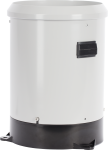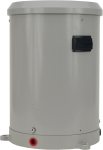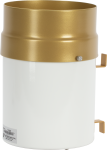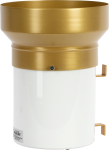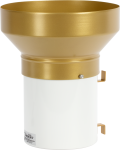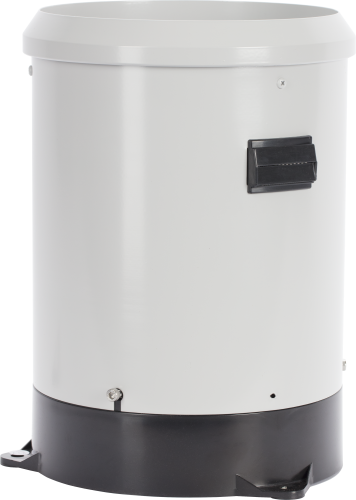
概要
HS Hyquest Solutions 社製の TB4 は、8 インチの開口部を備え、0.01 インチ単位で雨量を測定できる高性能の転倒マス雨量計です。激しい雨が降る可能性のある場所に最適です。この転倒マスは、すべての Campbell Scientific データロガーと互換性があり、環境モニタリングアプリケーションで使用されます。
続きを読む利点と特徴
- 毎時500mmの高降水量でも精度は±3
- 高強度の降水量をより正確に測定
- 0.01インチ単位の高精度チップ
- ほとんどのCampbell Scientificデータロガーに対応
イメージ

詳細
仕様
| センサタイプ | サイフォンとデュアルリードスイッチを備えたティッピングバケット |
| 測定の不確かさ |
|
| チップあたりの降雨量 | 0.254 mm (0.01 in.) |
| 測定範囲 | 0 ~ 700 mm/h (0 to 27.6 in./h) |
| 動作温度範囲 | 0° ~ 70°C |
| 湿度範囲 | 0 ~ 100% |
| ケーブルタイプ | 2導体シールド |
| 排水管サイズ | どちらのフィルタも、内径 12 mm (0.47 インチ) のチューブに対応しています。 |
| オリフィス直径 | 20 cm (7.9 in.) |
| 高さ | 33 cm (13 in.) |
| 重量 | 2 kg (4.4 lb)7.62 m (25 ft) 信号ケーブル付き |
互換性
注意: 以下は代表的な互換性情報を示しています。互換性のある製品や互換性のない製品をすべて網羅したリストではありません。
Data Loggers
| 製品 | 互換性 | 注意 |
|---|---|---|
| CR1000 (リタイア) | ||
| CR1000X (リタイア) | ||
| CR300 (リタイア) | ||
| CR3000 (リタイア) | ||
| CR310 | ||
| CR350 | ||
| CR6 | ||
| CR800 (リタイア) | ||
| CR850 (リタイア) |
互換性に関する追加情報
取り付け
本体のベースは 3 本の脚で支えられています。CM240 レベリングベースとマウント、またはレベリング機能を備えたユーザー提供のベースプレートの使用を推奨します。CM240 は、CM300 シリーズの取り付けポール、またはユーザー提供の 1.5 IPS (外径 1.9 インチ、ねじなし) パイプに取り付けることができます (注文情報を参照)。コンクリート パッドの使用をお勧めします。
ウインドスクリーン
Campbell Scientificは、雨量測定における風の影響を最小限に抑えるために、260-953 ウィンドスクリーンを提供しています。このウィンドスクリーンは、自由に垂れ下がり、風が通過すると揺れる 32 枚の板で構成されています。
ドキュメント
よくある質問
TB4-Lに関するよくある質問の数: 13
すべて展開すべて折りたたむ
-
CM240 は、CS700-L、TB4-L、および廃止された 385-L 雨量計に適合します。
-
データが正しく記録されていない場合は、次の 2 つの原因が考えられます。
- リードスイッチが故障しました。
- 雨量計からデータロガーへの接続に欠陥があります。これは通常、導体の破損または配線の腐食によって発生します。
-
- 3 本のネジを外し、ハウジングを上に持ち上げて、ハウジング アセンブリをベースから取り外します。
- 気泡レベルをチェックして、雨量計が水平になっていることを確認します。
- 内側の漏斗から水を注ぎ、2 つのバケツの表面を濡らします。メスシリンダーを使用して、15 分かけて 314 cc (19.16 in3) の水を収集漏斗にゆっくりと注ぎます。この水の量は、降雨量 0.39 インチ (10 mm) に相当します。
- 水が雨量計を通過した後、転倒バケツは TB4-L または CS700-L の場合は 39 回、TB4MM-L の場合は 50 回傾いているはずです。
- 雨量計が正しい転倒回数を記録しない場合は、ユニットを Campbell Scientific に返送して再調整してください。
-
パルス信号が無い、または重複する。
-
以下を試してみることをおすすめします:
- リード スイッチへの接続がしっかりしていることを確認します。ネジはしっかりと締められ、ワイヤはネジにしっかり接続されている必要があります。
- 現在使用しているリード スイッチからセカンダリ リード スイッチ接続に切り替えてみます。
- ケーブルがデータロガーの正しい入力に接続されていることを確認します。ケーブルのもう一方の端 (センサ側) にある 2 本のワイヤを一緒に触れます。データ ロガーはパルスを受信するはずです。パルスが記録された場合、問題はリード スイッチにあります。リード スイッチを交換します。
- データロガーがまだパルスを受信しない場合は、別のケーブルを使用してみてください。
-
260-953 Alter 型雨量計風防は、自由に垂れ下がり、風が通過すると揺れる 32 枚の重金属の葉で構成されています。揺れる葉は風ダンパーとして機能し、乱流を増やすことなく、雨量測定に対する風の影響を最小限に抑えます。
-
想定以上または以下の雨量でマスが傾く場合です。
-
最も一般的なエラーは、雨量計の校正がずれているように見えるか、またはデータロガーによって雨量計の先端が正しく記録されていないかのいずれかです。
-
すべてのセンサに異なるケーブル終端オプションがあるわけではありません。特定のセンサで利用可能なオプションは、センサ製品ページの注文情報エリアの 2 つの場所で確認できます。
モデル番号
ケーブル終端オプション リスト
センサが –ET、–ETM、–LC、–LQ、または –QD バージョンで提供されている場合、そのオプションが利用可能かどうかはセンサモデル番号に反映されます。たとえば、034B は 034B-ET、034B-ETM、034B-LC、034B-LQ、および 034B-QD として提供されています。その他のすべてのケーブル終端オプション (利用可能な場合) は、センサ製品ページの注文情報エリアの「ケーブル終端オプション」の下にリストされています。たとえば、034B-L 風力発電セットは、034B-L 製品ページの注文情報エリアに示されているように、–CWS、–PT、および –PW オプションで提供されています。
注意: 新しい製品が在庫に追加されると、通常は複数のモデル番号を作成するのではなく、1 つのセンサモデルの下に複数のケーブル終端オプションをリストします。たとえば、HC2S3-L には、HC2S3-LC モデルではなく、CS110 に接続するための –C ケーブル終端オプションがあります。
-
Campbell Scientific のセンサのほとんどは、ユーザー指定のケーブル長を示す –L として提供されています。センサが –LX モデル (「X」は他の文字) としてリストされている場合、そのセンサのケーブルの長さはユーザー指定ですが、固有のシステム用の特定のコネクタで終端されます。
- -LC モデルには、ET107、CS110、または廃止された Metdata1 に接続するためのユーザー指定のケーブル長があります。
- -LQ モデルには、RAWS-P 気象ステーションに接続するためのユーザー指定のケーブル長さがあります。
センサのメイン モデル番号の後に –L または –LX の指定がない場合、センサのケーブル長は設定されています。ケーブル長は、製品の注文情報の説明フィールドの末尾に記載されています。たとえば、034B-ET モデルの説明は、「ET ステーション用 Met One Wind セット、67 インチ ケーブル」です。ケーブル長が設定されている製品は、デフォルトでバラ線で終端されます。
ケーブルが特定のシステム用の特別なコネクタで終端されている場合、モデル番号の末尾でそのシステムを指定します。たとえば、034B-ET モデルは、ET107 システムのセンサを 034B として指定します。
- –ET モデルは、ET107 気象ステーション用のコネクタです。
- –ETM モデルは ET107 気象ステーション用のコネクタですが、交換部品を購入するときに便利な特別なシステム マウントも含まれています。
- –QD モデルは、RAWS-F クイック展開ステーション用のコネクタです。
- –PW モデルは、PWENC または配線済みシステム用のコネクタです。
ケーススタディ
概要 南アフリカのエスワティニ王国は、農業を基盤とした経済と150万人未満の人口を抱えており、気候変動の影響を非常に受けやすい国です。この国は天水農業と天然資源に大きく依存しているため、降雨パターンの変動や干ばつや洪水などの極端な気候条件の影響を受けやすい国です。研究によると、エスワティニでは干ばつ、洪水、激しい雷、風/雹嵐、その他の異常気象など、気候関連の災害の頻度と深刻度が高まっています。これらの現象は、農業、水、観光、健康、インフラなどの重要な分野に悪影響を及ぼし、国の経済に悪影響を及ぼしています。 課題 エスワティニの国立気象サービス (MET) は、気象と気候の状況を監視し、生命と財産の安全のために勧告を出すために設立されました。しかし、既存の早期警報システム (EWS) は、気候変動のリスク、脆弱性、危険に関する包括的な知識を生み出すには不十分でした。この制限により、国は気候変動のリスクに対処するための効率的な計画、監視、緩和、適応策を実施することができません。そのため、EWS と気候サービスを改善するために、エスワティニの気象と気候の監視、データ分析、情報発信の能力を強化することが急務でした。 解決策 METでは、国連環境計画(UNEP)と国連開発計画(UNDP)の資金提供を受けて、エスワティニに20基の自動気象観測所(AWS)を設置・配備する取り組みが行われました。 エスワティニにおけるEWSと気候サービスの強化は、気候変動への適応、生命、生活、環境の保護、持続可能な開発の促進に向けた同国の取り組みに貢献することになります。 エスワティニでの AWS の導入 AWS の設置場所は慎重に選定され、UNEP 用に 10 か所、UNDP......続きを読む
問題 — 緑の屋根の性能を最適化する方法 トロント大学のグリーン ルーフ イノベーション テスト ラボ (GRIT ラボ) は、断熱、降雨吸収、美観と環境面での利点を提供する植物床で覆われた屋根であるグリーン ルーフの性能を調査し、最適化するために設立されました。GRIT ラボは、気象観測所と 1.22 m x......続きを読む
Privacy Policy Update
We've updated our privacy policy. 詳細はこちら
Cookie Consent
Update your cookie preferences. クッキーの設定を更新する
